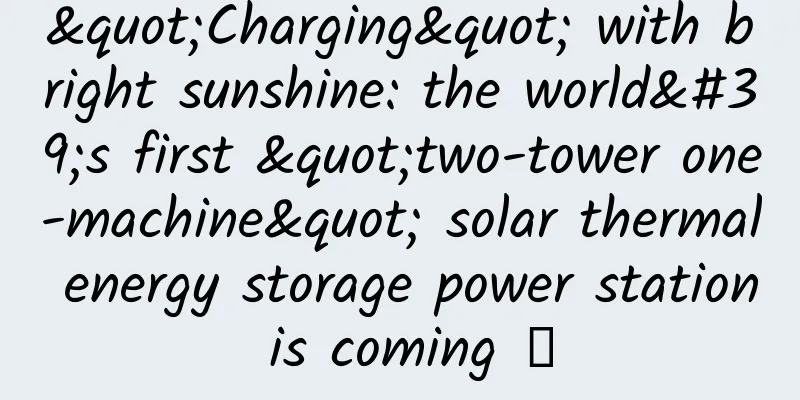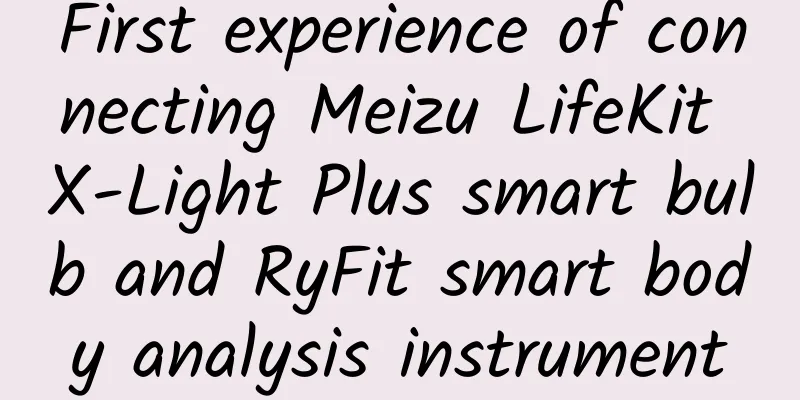"Charging" with bright sunshine: the world's first "two-tower one-machine" solar thermal energy storage power station is coming →

|
Author: Duan Yuechu and Huang Yanhong In the wave of global energy transformation, the development and utilization of renewable energy has become the focus of the times. On July 16, 2024, the Three Gorges Group received exciting news: the main project of the world's first "dual tower and one machine" solar thermal energy storage power station has entered the commissioning stage. The engineering team is going all out and strives to achieve production and power generation by the end of this year. This is a major breakthrough in the energy field and opens up a new path for future energy development. As an emerging renewable energy utilization method, solar thermal energy storage technology has gradually come into view in recent years. Unlike traditional photovoltaic power generation, solar thermal power generation uses a large number of heliostats to focus sunlight on a heat absorption tower, heat molten salt and other heat transfer media, generate steam to drive steam turbines to generate electricity, and store excess heat and release it when needed to achieve continuous and stable power output. This technology has a long heat storage time, fast response speed, and stable output power, which is of great significance to solving the intermittent and instability problems of renewable energy and improving the grid's acceptance capacity. The world's first "dual tower and one machine" solar thermal energy storage power station built by the Three Gorges Group has achieved major breakthroughs in technological innovation and application models. The power station is equipped with two adjacent heat-absorbing towers, sharing a steam turbine generator. Nearly 30,000 heliostats are installed under the towers, and the lighting area reaches 800,000 square meters. Wen Jianghong, project manager of the Guazhou solar thermal energy storage project of the Three Gorges Group, introduced that the power station uses mirrors that track the rotation of the sun to concentrate sunlight into the heat-absorbing tower to heat the molten salt and drive the steam turbine to generate electricity. This unique design can increase the optical efficiency by about 24% under the same boundary conditions, greatly improving the utilization efficiency of solar energy and the power generation capacity of the power station. In addition, the power station is equipped with a 6-hour molten salt heat storage system, like a huge "power bank", which stores excess heat when the sun is sufficient and releases it at night or on cloudy days when the solar energy is insufficient, ensuring the power station's continuous and stable power output. This peak-shaving performance enables the solar thermal energy storage power station to better coordinate with the power grid and provide stable power support for the power grid, which is of great significance to improving the safety and reliability of the power grid. From the macro perspective of energy development, the construction of the world's first "dual tower and one machine" solar thermal energy storage power station is of far-reaching significance. First, it provides new technical paths and solutions for the large-scale application of renewable energy. As the global demand for clean energy grows, solar thermal energy storage technology is expected to become an important part of the future energy structure, complementing renewable energy such as wind power and photovoltaics to jointly promote energy transformation. Secondly, the construction of power stations will help improve my country's technical level and industrial competitiveness in the field of solar thermal energy storage. Against the backdrop of fierce global competition in energy technology, mastering advanced solar thermal energy storage technology is crucial to my country's voice and influence in the energy field. Finally, the development of solar thermal energy storage power stations has a positive effect on reducing carbon emissions and responding to climate change. Using clean energy such as solar energy to replace traditional fossil energy can effectively reduce greenhouse gas emissions and contribute to achieving global climate goals. However, the development of solar thermal energy storage technology faces challenges. On the one hand, the construction cost of solar thermal energy storage power stations is high, and it is necessary to reduce costs and improve technical and economic efficiency before large-scale promotion and application. On the other hand, solar thermal energy storage technology has technical bottlenecks in materials, equipment, and processes, and it is necessary to increase R&D investment, strengthen industry-university-research cooperation, and break through key technical difficulties. In addition, the development of solar thermal energy storage power stations requires policy support and guidance, and the formulation of reasonable policy measures to encourage enterprises to increase investment and promote the healthy development of the industry. Despite many challenges, the construction of the world's first "dual-tower, one-machine" CSP energy storage power station has injected strong impetus into the development of CSP energy storage technology. I believe that in the near future, with technological progress and cost reduction, CSP energy storage technology will be widely used around the world, providing a solid energy guarantee for the sustainable development of human society. We look forward to the smooth commissioning of the power station by the end of this year, and we also look forward to CSP energy storage technology creating more miracles in the future and bringing more green and bright to life. The advantages of solar thermal energy storage technology are as follows: 1. Energy storage capacity: With large capacity and long-term energy storage characteristics, the molten salt heat storage system can store excess heat and achieve energy storage for several hours or even longer. It can generate electricity continuously and stably even when there is no sunlight, and the output power is stable, which helps the smooth operation of the power grid and the stable supply of electricity. 2. Peak-shaving performance: It has fast response speed and can quickly adjust the power generation according to the needs of the power grid. It has good peak-shaving ability, which is of great significance to the peak-shaving and frequency regulation of the power grid and can better adapt to changes in power demand. 3. Dispatchability: Compared with energy forms such as solar photovoltaic power generation that rely on weather and time periods, the power generation process of solar thermal energy storage power stations is easier to control and dispatch, and power generation plans can be flexibly arranged according to electricity demand. 4. Compatibility: It is compatible with traditional thermal power generation systems, making use of existing thermal power generation infrastructure and technologies to reduce the difficulty of technology transformation and application. 5. Environmentally friendly and sustainable: It uses solar energy as its energy source and does not produce greenhouse gas emissions or other pollutants during operation. It is environmentally friendly and a sustainable clean energy technology. The disadvantages of solar thermal energy storage technology are as follows: 1. High cost: The construction of a solar thermal energy storage power station requires a large number of heliostats, heat absorption towers, heat storage systems and other equipment. The initial investment cost is high, covering equipment procurement, installation, land use and other expenses. 2. Energy conversion efficiency: In the process of converting solar energy into electrical energy, the overall energy conversion efficiency is low, and part of the solar energy is lost during transmission and conversion. 3. Dependence on weather conditions: Although energy storage systems can alleviate the problem, prolonged periods of rain or sandstorms and other severe weather conditions will affect the collection and utilization of solar energy and reduce power generation efficiency. 4. Large area occupied: Since a large number of heliostats need to be installed to collect solar energy, solar thermal energy storage power stations usually require a large area of land, which is limited in areas with tight land resources. Ways to reduce the cost of CSP technology include: 1. Technological innovation and R&D: - Material innovation: Develop high-performance, low-cost heliostat materials, heat-absorbing materials, and heat-storage materials. For example, find efficient and low-cost reflective materials to manufacture heliostats, and develop new low-cost high-temperature molten salt formulas for heat storage systems. - Process improvement: Optimize the design and construction process of CSP power stations, improve equipment manufacturing and installation efficiency, and reduce construction costs. For example, improve the production process of heliostats to increase efficiency and reduce costs. 2. Economies of scale: - Large-scale construction: Through the large-scale construction of solar thermal energy storage power stations, equipment mass production and procurement can be achieved, reducing unit costs. As the number and scale of projects increase, the costs of each link in the industrial chain will be reduced due to economies of scale. 3. Improve system efficiency: - Improvement of optical efficiency: Optimize the heliostat arrangement and tracking system to improve the efficiency of solar energy collection and conversion, reduce energy loss, and lower the unit power generation cost. - Improved heat transfer efficiency: Improve heat transfer efficiency in heat absorption, heat transfer and heat storage processes, reduce heat loss and improve overall system efficiency. 4. Industry collaboration and supply chain optimization: - Industrial collaboration: Strengthen cooperation and collaboration among upstream and downstream enterprises in the solar thermal energy storage industry chain, promote technology sharing and resource integration, and reduce transaction costs. - Supply Chain Management: Optimize the supply chain, reduce raw material procurement and transportation costs, and ensure timely supply of equipment and materials with stable quality. 5. Policy support and subsidies: - The government has introduced policy support, such as tax incentives, loan incentives, and investment subsidies, to reduce project financing and construction and operating costs, and promote the development and application of solar thermal energy storage technology. 6. Operation and maintenance optimization: - Intelligent operation and maintenance: Utilize the Internet of Things, big data and artificial intelligence technologies to realize intelligent operation and maintenance of CSP power stations, improve operation and maintenance efficiency and reduce operation and maintenance costs. - Preventive maintenance: Establish a scientific equipment maintenance plan to reduce equipment failures and downtime through preventive maintenance, thereby reducing maintenance costs. The impact of the shortcomings of solar thermal energy storage technology on its application is as follows: 1. Impact of higher costs: - Limited investment attractiveness: The high initial investment cost makes investors cautious in their decision-making, reduces their enthusiasm for investing in CSP energy storage projects, and makes it more difficult to raise funds for projects. - Difficulty in market promotion: High costs are reflected in electricity costs, and the price of solar thermal energy storage power generation is relatively high. It is at a disadvantage in the market competition with traditional energy and other renewable energy sources (such as low-cost photovoltaic power generation), which limits its large-scale promotion and application in the energy market. - Slowing development speed: Cost constraints have limited the construction speed and scale expansion of solar thermal energy storage projects, slowing down the industrialization and commercialization process, and affecting its rapid popularization and increase in share in the energy field. 2. Impact of low energy conversion efficiency: - Low energy efficiency: Low conversion efficiency requires a larger collector field and more equipment to obtain the same electrical energy output, resulting in waste of resources and more space occupation such as land. - Poor cost-effectiveness: The same solar energy input produces less electricity, which reduces the cost-effectiveness of CSP projects and calls their economic feasibility into question, affecting the project's return on investment and commercial attractiveness. - Increased demand for space and resources: To obtain sufficient electricity, more land is needed to arrange solar collectors, and more raw materials and energy are needed to manufacture and operate equipment, increasing the demand and pressure on resources such as land, materials and energy. 3. Dependence on weather conditions: - Power supply stability issues: In rainy, dusty weather, insufficient solar energy is collected, and power generation capacity drops significantly or even fails to generate electricity, making it difficult to continuously and stably supply power to the grid, affecting grid stability and reliability. - Challenges of compatibility with the power grid: Unstable power output makes it more difficult for CSP power stations to coordinate with the power grid, bringing challenges to grid dispatching and management, and other backup power sources are needed to make up for periods of insufficient power supply. - Limited application areas: Weather conditions make solar thermal energy storage technology more feasible in areas with abundant sunlight resources and stable climate, while its application is limited in rainy, cloudy and foggy areas, limiting its widespread global application. 4. Impact of large land area: - Competition for land resources: The demand for large areas of land competes with other land uses such as agriculture, urban construction, and ecological protection, and it is difficult to find suitable construction sites in areas with scarce land resources. - Difficulty in project site selection: Due to the large land area, site selection needs to consider factors such as land cost, availability, and distance to grid access, which increases the complexity and difficulty of project site selection, or may extend the project construction period and increase costs. - Ecological and environmental impact: The construction of large-scale solar thermal energy storage power stations may have an impact on the local ecological environment, such as destroying vegetation and affecting wildlife habitats, causing environmental problems and social disputes. |
<<: My mouth feels astringent after eating cucumbers. Is it pesticide residue?
Recommend
How can SEO novices write a good TKD?
Student asked: What is TKD? Teacher’s answer: TDK...
Information flow and QQ advertising lead conversion solution!
The competition for traffic is fierce, and last m...
6 tips to improve push opening rate of APP!
The main purpose of push is to promote activation...
[Practical Collection] A comprehensive list of efficient tools necessary for operating Meow and Market Wang
As the saying goes, "If you want to do your ...
How did the Eight Immortals cross the sea? What magical powers did they display?
Everyone has heard of the mythical story "Ei...
SAIC has established a commercial vehicle intelligent driving technology innovation company. Autonomous driving will be first implemented in ports, factories, and trunk logistics scenarios
(August 26, 2021, Shanghai) SAIC Motors announced...
Himalaya FM audio traffic promotion plan
Himalaya FM is a well-known audio sharing platfor...
Shh...listen to what little secrets the plants are whispering?
Figure 1 shows the tree-like Calligonum mongolicu...
Douyin operation: 5 major Douyin monetization models!
Someone once said that the formula for making mon...
iPad air 2 is coming: is the gravedigger of notebooks coming?
Recently, there have been media reports that acco...
About improving operational conversion rate (Part 1)
When users use a product, there are always two op...
Why do the holidays go by so fast?
Author: The Nutcracker Studio Many people have th...
Over 50 billion bacteria! This kitchen tool that every household uses should really be replaced! (Recommendations included)
Where do you think your home is most likely to br...









